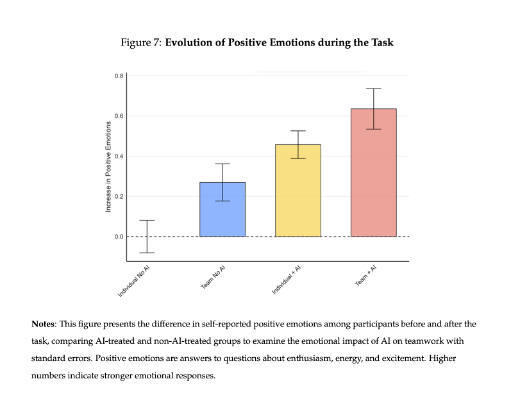1+1+AI=5: How Generative AI Is Empowering Teams
We often talk about AI through the lens of individual productivity: automating tasks, accelerating workflows, and reducing costs. But there’s something far more powerful — and far less discussed — emerging in front of us: the impact of generative AI on teams — not just replacing tasks but reshaping how people work together. That’s the story behind one of the most fascinating studies I’ve seen this year, a large-scale experiment conducted with 776 professionals, in commercial and R&D spaces, at Procter & Gamble (P&G) in collaboration with researchers from Harvard University, the Wharton School of the University of Pennsylvania, and ESSEC Business School in France.
The question the study asked was bold: Can AI act as a teammate? This means more than just a tool but a genuine contributor to team dynamics, performance, and emotional experience. The study’s findings should provide inspiration for any tech and business leader who is rethinking the operating model of collaboration in an AI-enabled enterprise.
AI Equals And Augments Human Collaboration
In traditional settings, teams outperform individuals by integrating diverse perspectives. But what happens when an individual is paired with genAI? The study found that individuals using generative AI matched the performance of human teams working without it. More strikingly, teams with genAI outperformed everyone else, producing higher-quality, faster solutions with more comprehensive detail. We’re talking real business challenges that P&G employees tackle in their day-to-day work.

AI Breaks Down Silos
If you’ve ever led a cross-functional team, you’ve seen how people’s ideas tend to reflect their domain: R&D folks skew technical, while commercial folks lean toward marketability. Collaboration helps blend those ideas, but it takes time, trust, and iteration.
Here’s what changed with AI: Those silos started to dissolve. With genAI, both R&D and commercial professionals produced solutions that were balanced — integrating both technical and commercial dimensions. The genAI interface nudged them there. It helped them think beyond their professional default. In other words, genAI is enabling cross-functional thinking at the point of creation. That’s not task automation — that’s meaningful, intellectual contribution. For CIOs, this opens the door to rethinking how we configure teams, how we design roles, and how we structure collaboration.
AI Makes Work More Human
There’s one more dimension, and it might be the most surprising. We tend to associate technology adoption with friction, stress, and overload — not here. Participants using AI reported significantly higher positive emotions: more excitement, more energy, less frustration. In fact, individuals working with AI felt as positive about the experience as people collaborating in human-only teams. And when teams used AI together? Emotional engagement surged even higher.
When was the last time that we saw a piece of technology improve morale?

1+1+AI=5
This isn’t just a productivity story. It’s a human story. AI, used well, doesn’t just get the job done; it makes people feel more confident, more creative, and more connected to the work. That’s true empowerment. That’s why 1+1+AI doesn’t equal 3; it equals 5.
This study was conducted with prior-generation models not optimized for team interaction. So imagine what’s possible when tech and business leaders start building AI into workflows designed for collaboration. We can move from using genAI as a tool to automate tasks to one that reinvents workflows by integrating it as a core part of how teams think, solve, and create together, because the future of work isn’t just faster; it’s more human, more inclusive, and — if we design it right — more extraordinary than we imagined.
